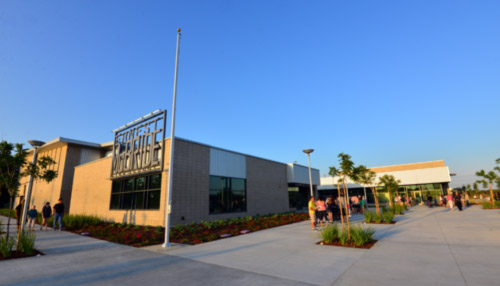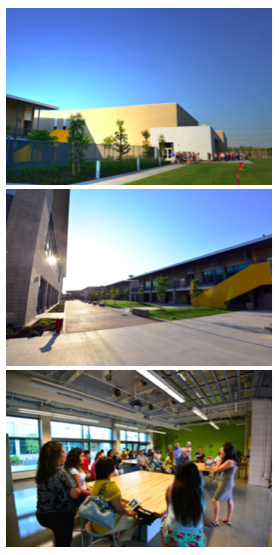McBride High School: The Culmination of a Most Collaborative Journey
 Last Tuesday, in the warm, golden light of a blazing summer sun making its approach toward twilight, McBride High School opened its doors to a host of prospective students, anxious parents, curious neighbors and any other interested parties looking for a glimpse at Long Beach Unified School District's newest learning academy. When it officially opens this September, Ernest S. McBride, Sr. High School will offer a thematically structured learning environment set within state-of-the-art spaces that incorporate a variety of sustainable design initiatives.
Last Tuesday, in the warm, golden light of a blazing summer sun making its approach toward twilight, McBride High School opened its doors to a host of prospective students, anxious parents, curious neighbors and any other interested parties looking for a glimpse at Long Beach Unified School District's newest learning academy. When it officially opens this September, Ernest S. McBride, Sr. High School will offer a thematically structured learning environment set within state-of-the-art spaces that incorporate a variety of sustainable design initiatives.
I attended this neighborhood open house for several reasons:
- This school has occupied a major part of the last five years of my time at LPA. I've grown with the project as it's evolved through the design development phase, accelerated into construction documents, hustled through the approvals process, and endured an action-packed two year construction cycle.
- I was also eager to see the school in a near finished state, cleaned up from the general "construction dust" of a job site but also not yet affected by the fingerprints of daily occupation. This could be as pure of state as I might ever see this school, and it represented a significant milestone.
- Perhaps most importantly, I wanted to witness the community reaction and gauge what kind of an impact this school will have, even well after I've left my last imprint and moved onto other projects. We architects and designers often immerse ourselves in the details of design execution and focus on the technical aspects of realizing our vision. But it's equally important to assess how our work shapes the ultimate users.
 Happily, the event exceeded expectations. I arrived with several colleagues who have been a part of the sustainable design team since the beginning, and we were amazed at the turnout. Some expectations had pegged the total guest count in the few hundreds. Instead, a throng of eager visitors showed up, stretching from the front gates across to the parking area, out onto the sidewalk a couple hundred feet away, and then down the street. A casual onlooker might have mistaken this for the line to a concert. And throughout the two hour event, guests continued to arrive.
Happily, the event exceeded expectations. I arrived with several colleagues who have been a part of the sustainable design team since the beginning, and we were amazed at the turnout. Some expectations had pegged the total guest count in the few hundreds. Instead, a throng of eager visitors showed up, stretching from the front gates across to the parking area, out onto the sidewalk a couple hundred feet away, and then down the street. A casual onlooker might have mistaken this for the line to a concert. And throughout the two hour event, guests continued to arrive.
Once inside the campus, everyone was shuttled through a tour of multiple spaces across all seven buildings of the school, with stopping points where stationed guides would explain the use of the space, the backstory of the planning and design process, and unique technologies, features, and planned curriculum. Exploring the open, spacious library to the industrial, well-equipped engineering labs to the soaring gymnasium to the sleek, modern lecture hall, guests gained insight into what the select future students of this green school would be engaging.
As I filtered through groups to gauge audience responses, I saw many people actually touching and inspecting finishes and building materials, possibly intrigued at a fine level of design not typically associated with schools. The earthy weightiness of the concrete masonry block, the contemporary elegance of the translucent polycarbonate panels, and the sleek texture of the metal paneling created a refined space, representative of progressive trends in K-12 design. There were nods of approval toward the flexible learning environments and impressed murmurs toward the technology and infrastructure featured in each area. People seemed to enjoy the idea of the gymnasium and play fields being joint use facilities with the city. Guests warmly received the highlighted sustainable measures, and I noticed many pleasantly surprised reactions to the large, open parkland in front of the school that returns a greenbelt back to the community.
I appreciated how knowledgeable many of the guests already were, detailing to their companions the same information being dispensed by the guides. This speaks to an actively engaged community that clearly values the education and future of its children.
Indeed, one fact highlighted throughout the event was the level of collaboration and involvement that pervaded the whole design process—not just among architects, engineers, contractors and the client, but also with neighboring denizens, council members, learning authorities, outside companies and career professionals—to mold the thematic high school curriculum tracks and subsequent design direction of the school. Given that I've been involved in regular construction meetings, site visits, and correspondence with the builders and client representatives for this project, I didn't expect to learn anything new about the school. But the excitement and interest in McBride High that I discovered was exhilarating and refreshing.
It's a long and often tortuous road toward the completion of a project, but I was reminded that the end result—the effect on the people who will be using it—makes everything worth it. Parents anticipating the great tools their children will be able to use as future students... teens engaging and asking about design features... and just plain people buzzing and discussing this new community arrival... brings uplifting satisfaction. It reinforces the reason I went into this field—to make a positive impact on the lives of others. And if the open house was any indication, I'm confident that McBride High School will be yet another sustainable school that enriches the lives of people who use them.
Albert Lam is a Project Coordinator at California-based LPA Inc. He is a LEED accredited professional who specializes in the design and implementation of K-12 schools.
